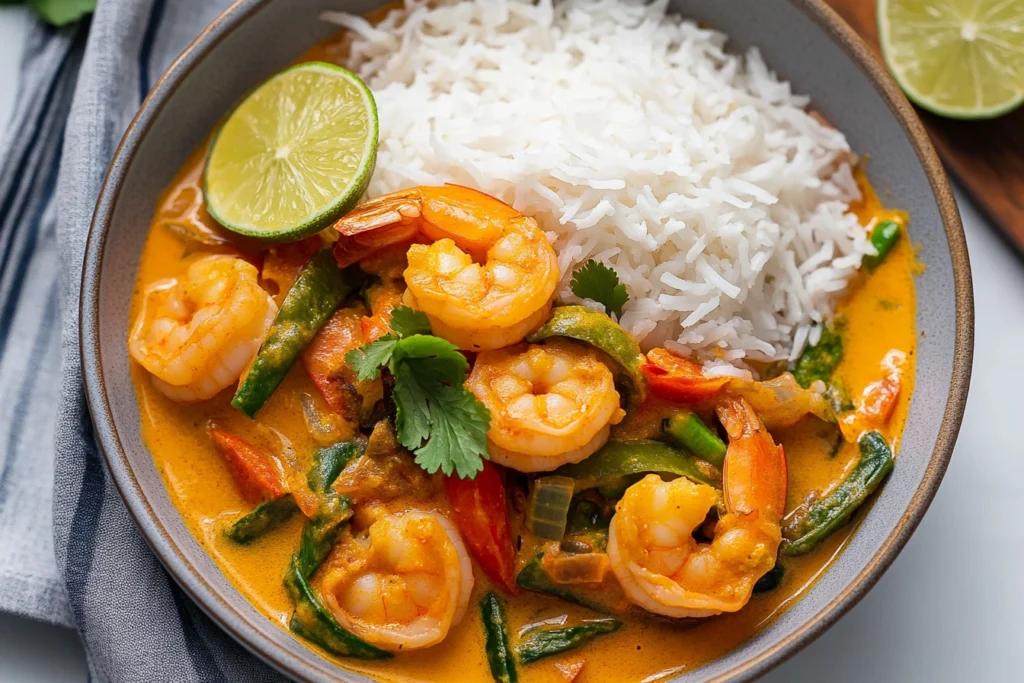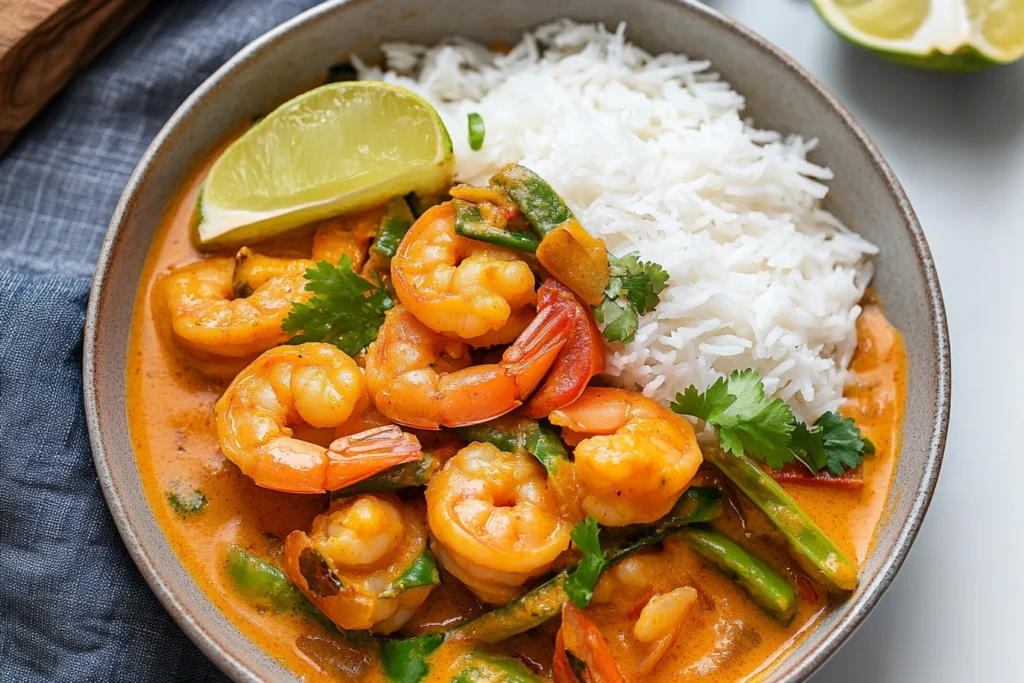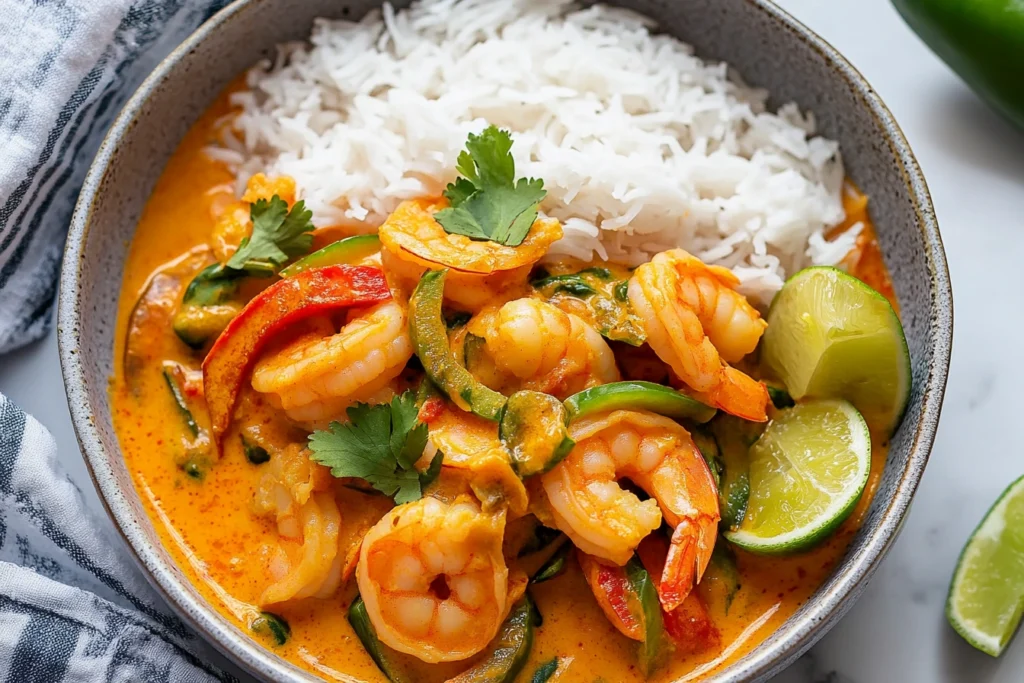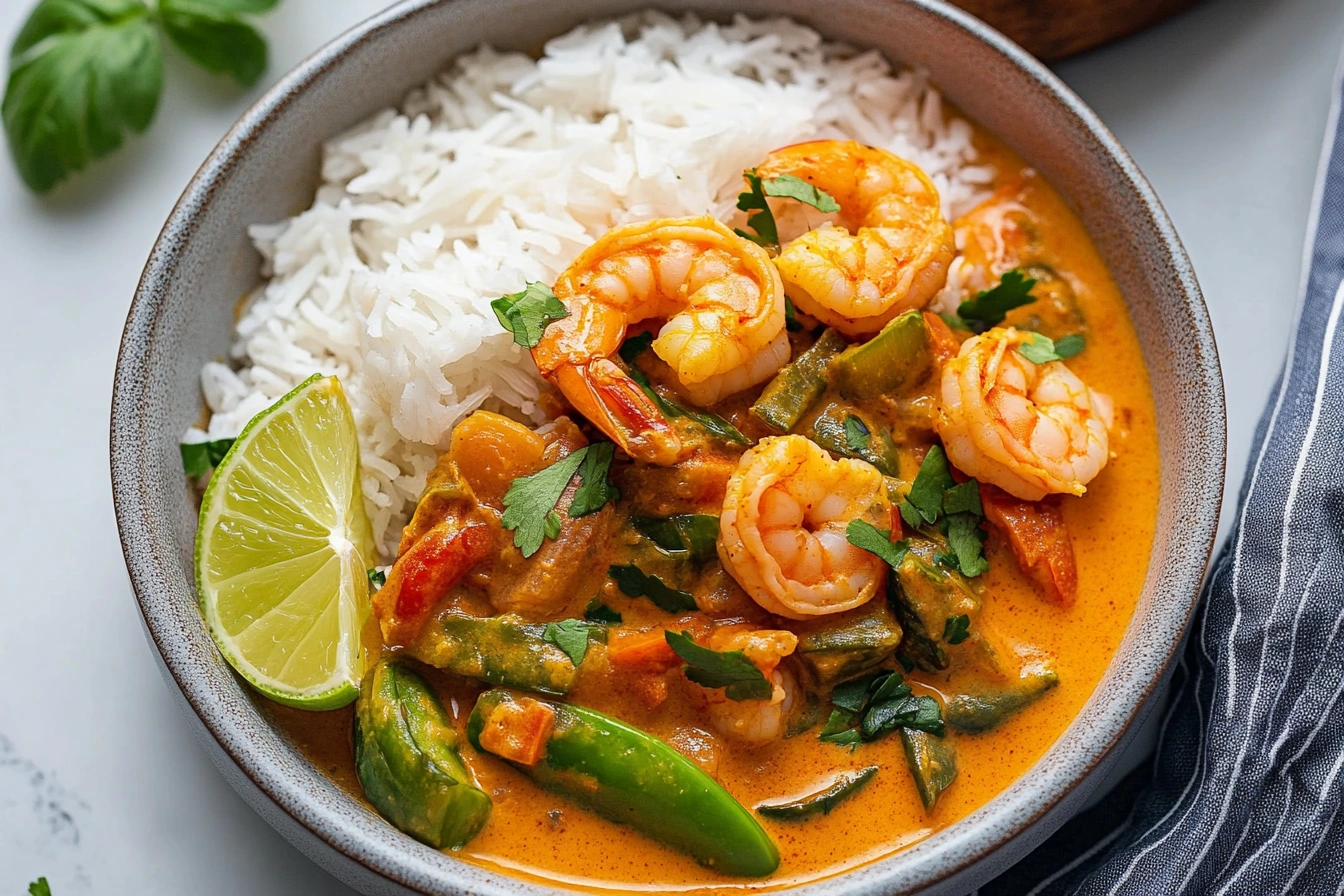Introduction
Coconut shrimp curry is one of those dishes that seems to effortlessly combine comfort, spice, and a touch of tropical sweetness. Suppose you’ve ever had the pleasure of tasting this creamy dish. In that case, you know just how delightful it is succulent shrimp simmering in rich coconut milk, with a harmonious blend of spices that brings everything together perfectly. It’s one of those meals that’s guaranteed to impress, whether it’s for a weeknight dinner or a special occasion.
In this article, we’ll be walking you through everything you need to know about creating the perfect coconut shrimp curry. We’ll cover everything from selecting the freshest shrimp to understanding the different types of coconut milk. We’ll also offer tips on how to customize the recipe to fit various tastes and dietary needs. So, grab your apron, because it’s time to cook up something delicious!
What is Coconut Shrimp Curry?
Coconut shrimp curry is a delicious dish that pairs the natural sweetness of coconut with the delicate flavor of shrimp. Often found in Southeast Asian cuisine, it has gained global popularity due to its rich and comforting texture. The main feature of this dish is the creamy, aromatic sauce made from coconut milk, spiced with a combination of turmeric, curry powder, and other seasonings.
The dish’s origins are often debated, but it’s most closely associated with Thai, Indian, and Caribbean cuisines. Each region offers a slight twist, incorporating local spices and herbs to create variations on the classic recipe. But no matter where it’s from, the dish always centers around the same basic idea: shrimp cooked in a rich, flavorful coconut sauce.
Flavor Profile and Key Ingredients of Coconut Shrimp Curry
The flavor profile of coconut shrimp curry is a delightful combination of sweet, savory, and spicy. The coconut milk forms the rich base of the sauce, contributing a creamy and slightly sweet taste. The spices such as curry powder, ginger, garlic, and turmeric bring a warm and fragrant depth of flavor, with a mild heat that can be adjusted according to preference.
When making coconut shrimp curry, it’s essential to use the right balance of ingredients to ensure the dish’s success. The key ingredients are:
- Shrimp: Fresh or frozen, shrimp forms the heart of the dish. Their delicate flavor works wonderfully with the creamy coconut sauce.
- Coconut Milk: The backbone of the sauce, giving it its signature creamy texture. You can use full-fat or light coconut milk, depending on your preference for richness.
- Spices: A mix of curry powder, turmeric, ginger, garlic, and sometimes chili peppers. These ingredients give the dish its distinctive warmth and depth of flavor.
- Aromatics: Onions, garlic, and ginger provide a fragrant base for the curry, making every bite feel comforting and aromatic.
These ingredients come together to create a well-balanced, flavorful sauce that coats the shrimp perfectly.
Health Benefits of Coconut Shrimp Curry
Beyond being incredibly tasty, coconut shrimp curry offers several health benefits. Let’s start with shrimp, which are a great source of high-quality protein and low in fat. They’re also rich in essential nutrients like vitamin B12, iodine, and selenium—important for maintaining healthy metabolic function and immune support.
Then, we have the coconut milk itself. While it’s known for being high in fats, most of these fats are medium-chain triglycerides (MCTs), which can provide quick energy for the body. Some studies have also suggested that MCTs may help in weight management by increasing calorie burning. Furthermore, coconut milk is naturally dairy-free, making it an excellent choice for those who are lactose intolerant or following a vegan diet.
Combined, shrimp and coconut milk form a nutritious base for this flavorful dish, making it a great option for a balanced meal. You can also make variations to the curry, adding vegetables like spinach or bell peppers, which not only enhance the flavor but also provide additional fiber and vitamins.

The Best Ingredients for Coconut Shrimp Curry
Shrimp Selection: Fresh vs. Frozen
One of the most important components of a coconut shrimp curry is, of course, the shrimp. But when it comes to choosing between fresh or frozen shrimp, the decision often depends on convenience, availability, and the desired outcome.
- Fresh Shrimp: If you’re lucky enough to find fresh shrimp at your local fish market, they are generally the best choice for flavor and texture. Fresh shrimp tend to have a firmer texture, which can stand up well to cooking in a curry. They also tend to have a cleaner, more natural taste that enhances the overall dish. However, fresh shrimp should be cooked relatively soon after purchase to ensure peak freshness.
- Frozen Shrimp: While frozen shrimp might not have the same fresh, delicate flavor as their fresh counterparts, they’re often a more practical option. They are available year-round, can be stored for long periods, and are usually more affordable. The key to making frozen shrimp work for coconut shrimp curry is ensuring they’re properly thawed. If you’re in a rush, simply place them in a colander under cold running water for a few minutes.
Whether fresh or frozen, be sure to choose high-quality shrimp. Look for shrimp that are firm, slightly translucent, and free from any off-putting smells. Also, make sure to peel and devein the shrimp before cooking, as this will make the curry more pleasant to eat.
Types of Coconut Milk for Curry
The coconut milk you choose plays a huge role in the final texture and taste of your coconut shrimp curry. There are a few different types of coconut milk on the market, and understanding their differences will help you pick the right one for your recipe.
- Full-Fat Coconut Milk: For the richest, most decadent curry, full-fat coconut milk is the way to go. This type has a high fat content, which results in a creamy, luscious sauce that coats the shrimp beautifully. It’s perfect for when you want a comforting, indulgent meal.
- Light Coconut Milk: If you’re looking for a slightly lighter option, light coconut milk is a good choice. It contains less fat than its full-fat counterpart but still has the distinct coconut flavor. While not as creamy, it’s a healthier alternative and works well for those who are watching their calorie intake.
- Coconut Cream: If you want a thicker, more concentrated coconut flavor, you can opt for coconut cream. It’s similar to full-fat coconut milk but has a much higher concentration of coconut solids. Coconut cream can give your curry a richer texture and taste, so use it sparingly or mix it with a bit of water to adjust the consistency.
When selecting coconut milk, always look for varieties that don’t contain unnecessary additives or preservatives. Many brands add sugar or artificial thickeners, which can alter the flavor of your curry. Opt for pure coconut milk or coconut cream for the best results.
Spices and Herbs to Use
The magic of coconut shrimp curry lies in the perfect balance of spices and herbs. From earthy curry powder to fragrant ginger, the right combination of seasonings can make all the difference. Here are the essential spices and herbs to use when making coconut shrimp curry:
- Curry Powder: This is the backbone of your curry’s flavor. The type of curry powder you use can vary depending on personal preference and regional variations. Indian curry powder is warm and earthy, while Thai curry powder tends to be a bit more aromatic and spicy. You can also experiment with different blends to find the perfect combination for your taste.
- Turmeric: This spice gives your curry its vibrant golden color and adds a subtle, warm bitterness. Not only does it enhance the flavor, but it also has anti-inflammatory properties, making it a great addition to any dish.
- Ginger and Garlic: Aromatic and full of flavor, fresh ginger and garlic are essential to coconut shrimp curry. Their sharpness and pungency complement the sweetness of the coconut milk and the richness of the shrimp.
- Cilantro and Lime: Fresh cilantro adds a pop of color and a refreshing flavor, while lime juice helps to balance out the richness of the coconut milk. These two ingredients make for a perfect finishing touch and bring a touch of brightness to the dish.
- Chili Peppers (optional): If you like your curry spicy, you can add fresh chili peppers or a dash of cayenne pepper. Just be mindful of the heat level and adjust according to your preference.
These spices and herbs come together to create a bold, well-rounded flavor that defines coconut shrimp curry. Feel free to experiment with the amounts to find the perfect balance of heat, sweetness, and warmth.
Optional Add-Ins and Variations
While the basic coconut shrimp curry recipe is already packed with flavor, you can add a variety of other ingredients to customize it to your tastes. Here are some options to consider:
- Vegetables: Adding vegetables can not only enhance the flavor but also increase the nutritional value of your curry. Popular choices include bell peppers, spinach, zucchini, or even sweet potatoes. These vegetables can be added to the curry along with the shrimp or cooked separately as a side dish.
- Protein Options: While shrimp is the classic protein for this dish, you can easily switch it out for other options. Tofu or tempeh are great plant-based alternatives that will absorb the coconut milk and spices beautifully. You could also use chicken or beef if you prefer a meat-based curry.
- Rice and Noodles: Serve your coconut shrimp curry with some steamed jasmine rice, basmati rice, or rice noodles for a well-rounded meal. These starches help to soak up the flavorful coconut sauce, making each bite even more satisfying.
By adjusting the ingredients to suit your taste, you can create your own unique version of coconut shrimp curry.
How to Make Coconut Shrimp Curry
Step-by-Step Coconut Shrimp Curry Recipe
Making coconut shrimp curry from scratch is simple and rewarding. Follow these easy steps to create a rich, creamy dish that will leave everyone craving more.
Preparation of Shrimp and Ingredients
Start by peeling and deveining the shrimp. If using frozen shrimp, be sure to thaw them properly. While the shrimp are draining, chop up your vegetables—onions, garlic, and ginger—and gather your spices. You’ll also need coconut milk and any optional veggies you want to add.
Cooking the Base: Aromatics and Spices
In a large pan, heat some oil over medium heat. Add the chopped onions, garlic, and ginger, cooking until soft and fragrant. Then, add your spices—curry powder, turmeric, and a pinch of salt. Stir everything together and let it toast for a minute to develop the flavors.
Creating the Coconut Curry Sauce
Once the spices are fragrant, pour in the coconut milk and bring the mixture to a simmer. Let it cook for about 5-10 minutes to thicken. If the sauce is too thick, add a splash of water or vegetable broth to reach your desired consistency.
Cooking the Shrimp and Final Touches
Add the shrimp to the pan, stirring gently to coat them in the sauce. Cook for 3-5 minutes until they turn pink and opaque. Taste the sauce and adjust the seasoning with salt, lime juice, or chili flakes if needed. Serve with freshly chopped cilantro for garnish.
Top Tips for a Perfect Coconut Shrimp Curry
- Don’t overcook the shrimp: Shrimp cook quickly, so be sure to remove them from heat as soon as they’re pink and opaque. Overcooking them can make them rubbery.
- Balance the flavors: Taste the sauce as you cook and adjust with more salt, sweetness, or spice as needed. Adding lime juice at the end can really elevate the flavor.
- Control the heat: For a milder curry, reduce the amount of chili or omit it entirely. If you like more heat, consider adding fresh chili peppers or cayenne.

Variations and Customizations of Coconut Shrimp Curry
Vegan Coconut Shrimp Curry: Plant-Based Options
To make a vegan coconut shrimp curry, simply swap the shrimp for tofu or jackfruit. Tofu absorbs the rich coconut milk, creating a similar texture to shrimp. Jackfruit, on the other hand, mimics the flaky texture of shrimp and pairs beautifully with the spices.
Low-Carb Coconut Shrimp Curry
For a low-carb version, skip the rice and serve the curry with cauliflower rice or sautéed greens like spinach or bok choy. You can also use zucchini noodles for a healthier twist. These substitutions help cut down on carbs while still giving you a satisfying meal.
Spicy Coconut Shrimp Curry: How to Turn Up the Heat
If you enjoy a spicier curry, increase the amount of chili peppers or add cayenne pepper to the mix. You can also drizzle some hot sauce into the curry for an extra kick. The heat will balance well with the sweetness of the coconut milk, creating a perfect contrast of flavors.
Pairing Coconut Shrimp Curry with Sides
Best Rice Pairings
When it comes to pairing coconut shrimp curry, rice is the go-to side dish. The creamy coconut sauce and tender shrimp go wonderfully with the soft texture of rice. Here are some great options:
- Jasmine Rice: This fragrant, fluffy rice is a classic pairing for coconut shrimp curry. Its subtle floral aroma complements the rich, creamy curry perfectly.
- Basmati Rice: Another excellent choice, basmati has a slightly nutty flavor and a long grain that holds up well with saucy dishes like curry.
- Coconut Rice: For an extra coconut kick, try cooking your rice with coconut milk. It’s a great way to deepen the coconut flavor and create a more cohesive dish.
Side Vegetables
To round out your meal, serve your coconut shrimp curry with some fresh vegetables. They add color, texture, and a nutritional boost:
- Steamed Broccoli: Lightly steamed broccoli adds a nice crunch and pairs well with the creamy sauce.
- Sauteed Spinach: Spinach has a mild flavor that works beautifully with the spices in the curry.
- Mixed Greens: A simple salad of mixed greens with a light vinaigrette can offer a refreshing contrast to the rich curry.
Bread Pairings
If you want something to soak up all that delicious curry sauce, opt for a piece of soft, warm bread:
- Naan: This soft, pillowy flatbread is perfect for scooping up curry. You can buy it at the store or make your own for a special touch.
- Roti: A slightly thicker flatbread, roti is also a great choice for dipping into the curry.
- Crusty Bread: For a more rustic option, serve a thick slice of crusty bread to mop up every last drop of sauce.
These sides provide a nice balance to the rich, creamy flavor of the coconut shrimp curry, making your meal even more satisfying.
Storing and Reheating Coconut Shrimp Curry
How to Store Coconut Shrimp Curry
If you have any leftovers, don’t worry! Coconut shrimp curry keeps well in the refrigerator and even tastes better the next day as the flavors meld together.
- Refrigeration: Allow the curry to cool completely before transferring it to an airtight container. It will keep for up to 3 days in the fridge.
- Freezing: While shrimp doesn’t freeze as well as other proteins, you can still freeze the curry. Just store it in a freezer-safe container, and it will last for up to 2 months. When ready to eat, thaw it overnight in the fridge.
How to Reheat Coconut Shrimp Curry
Reheating coconut shrimp curry is simple, but it’s important not to overcook the shrimp again. Here’s how you can do it:
- On the Stovetop: Place the curry in a saucepan over low heat. Stir frequently to ensure the shrimp doesn’t overcook. If the sauce is too thick, add a little coconut milk or water to loosen it up.
- In the Microwave: Place the curry in a microwave-safe container and heat in 30-second intervals, stirring in between. Be sure to monitor it so the shrimp doesn’t become tough.
- In the Oven: If you prefer using the oven, transfer the curry to an oven-safe dish, cover it with foil, and reheat at 350°F (175°C) for 15-20 minutes.

Frequently Asked Questions
What pairs well with coconut shrimp?
To complement coconut shrimp curry, serve it with:
- Rice: Jasmine, basmati, or coconut rice soak up the rich sauce.
- Vegetables: Steamed broccoli, sautéed spinach, or fresh greens add balance.
- Bread: Naan or roti are perfect for scooping up the curry.
These sides enhance the curry’s creamy texture and rich flavor.
How do Thai restaurants make curry so creamy?
Thai restaurants achieve creamy curries by using full-fat coconut milk, which gives a smooth texture and natural sweetness. The curry is simmered slowly to thicken, and ingredients like lemongrass, kaffir lime, and galangal add aromatic depth. The result is a velvety, fragrant sauce.
Can you put frozen prawns straight into a curry?
You can, but it’s best to thaw frozen prawns first for even cooking and better texture. If you cook them frozen, allow extra time, and drain any excess water to avoid diluting the sauce.
What’s the difference between Thai and Indian shrimp curry?
- Thai Shrimp Curry: Creamy with coconut milk, lighter in spices, and flavored with lemongrass, lime leaves, and galangal.
- Indian Shrimp Curry: Richer, with a blend of ground spices like cumin, coriander, and garam masala, often thicker due to tomatoes or cream.
Conclusion
Coconut shrimp curry is a delicious, creamy dish that combines shrimp, coconut milk, and aromatic spices into a comforting meal. It’s easy to make, versatile, and perfect for any occasion. Whether you enjoy it mild or spicy, with rice or vegetables, this curry is sure to satisfy. So, give it a try and enjoy the rich, tropical flavors of this simple yet flavorful dish!
Explore More Delicious Recipes:
Crab Brulee Recipe: A Luxurious Seafood-Inspired Twist on Dessert Crab Brulee Recipe

